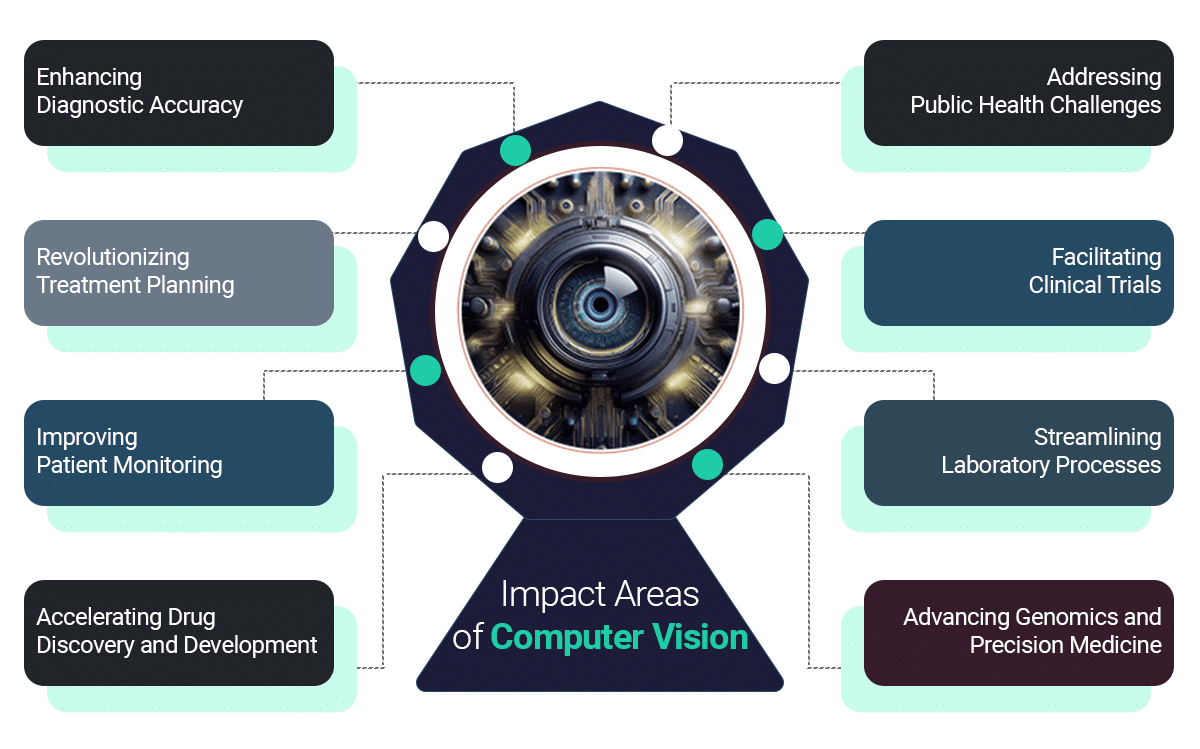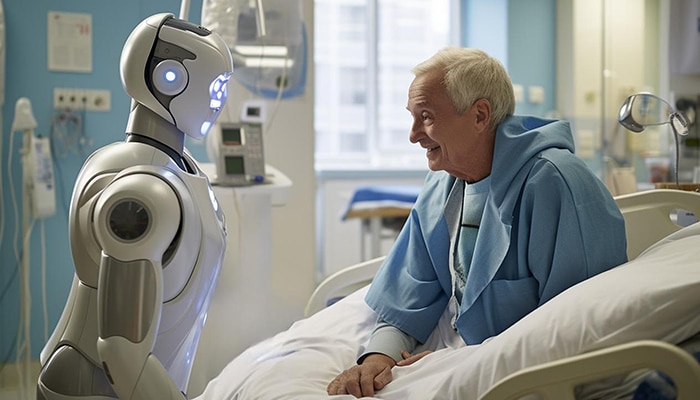As a generation, we are currently going through a unique collective experience – we occupy front-row seats as Artificial Intelligence (AI), along with its applications like computer vision, are overhauling life as we know it on this planet. The healthcare and life sciences industries act as two of the primary interfaces where we can actually feel this change in real time. In this piece, we attempt to understand how computer vision and its diverse applications are fundamentally changing how we diagnose and treat an ailing human body.
Enhancing Diagnostic Accuracy
One of the most important objectives of computer vision applications in healthcare is to attain improved diagnostic accuracy. As deep learning models such as Convolutional Neural Networks (CNNs) become increasingly common, healthcare systems can examine medical images with greater precision today. Engineers heavily depend on technologies such as TensorFlow, PyTorch, and OpenCV while developing such models.
Radiology and Imaging
Among the medical disciplines, radiology was one of the earliest adopters of computer vision. Algorithms that have been trained on vast datasets of X-rays, MRIs, and CT scans are now identifying anomalies such as tumors, fractures, or lesions with high levels of specificity. For example:
- Lung Cancer Detection: Computer vision can now analyze chest X-rays with models that screen for early indicators of lung cancer. It is often faster and provides greater accuracy compared to radiologists themselves.
- Brain Imaging: The brain is often referred to as the last frontier of medicine, as a complete understanding of its intricate anatomy has long remained a mystery. Yet, deep learning algorithms are now capable of finding abnormalities such as glioblastomas in routine MRI studies, which can lead to early interventions.
Pathology
Computer vision algorithms, coupled with digital slide scanners, can now perform an independent analysis of a tissue sample. Such systems as Whole Slide Imaging (WSI) allow for the creation of high-resolution pictures that are then scanned through the AI system to identify carcinogenic cells, quantify tumor regions, and classify diseases into subtypes.
Revolutionizing Treatment Planning
Computer vision plays a very important role in treatment planning, customization of care, and optimization of procedures.
Surgical Assistance
Computer vision powers the robotic-assisted surgeries that are now transforming operating rooms. Such systems as the da Vinci Surgical System use real-time imaging and AI to guide surgeons with precision, which was unimaginable in the pre-AI era. Key applications include:
- Augmented Reality (AR) Overlays: They allow surgeons to see anatomical structures in real-time using AR and make precise, complex surgeries possible.
- Minimally Invasive Surgery: Computer vision assists in finding the safest route to be followed by a surgeon to cause minimal tissue damage.
Radiation Therapy
AI-enabled computer vision models are being used to delineate the tumor boundaries for oncology cases that require radiation therapy. Similarly, tools like RayStation use AI mechanisms to ensure extremely accurate targeting with minimal destruction of healthy tissue.
Accelerating Drug Discovery and Development
Computer vision is also catalyzing some really time- and resource-consuming processes in drug discovery and development within the life sciences domain.
High-Throughput Screening
HTS involves the testing of thousands of compounds that may have potential therapeutic effects on a disease phenotype. Pharmaceutical companies make use of HTS in cell cultures, and images obtained from automated microscopes are analyzed with computer vision algorithms for interesting drug candidates. Common technologies applied along this workflow include CellProfiler and ImageJ.
Molecular Docking
While a mainly computational chemistry task, molecular docking (using AI-driven platforms like AlphaFold) benefits from computer vision when visualizing and analyzing protein-ligand interactions.
Improving Patient Monitoring
Computer vision also continues to improve in-patient monitoring, allowing for continuous and non-invasive observation.
Remote Monitoring
AI-enabled smart cameras can continuously monitor a patient’s condition to detect early signs of distress, such as irregular breathing or changed movement patterns. Such systems are of great use in an intensive care unit or an eldercare facility.
Wearable Devices
Wearable devices, such as smartwatches and fitness trackers, use computer vision to track activities and find anomalies. For example, some gait analysis algorithms are used to predict fall risks among older patients.
Advancing Genomics and Precision Medicine
Computer vision contributes a lot to genomics, where visual data analysis is the need of the hour to understand gene variations.
Genome Sequencing
Computer vision helps in the electropherogram analysis in genome sequencing, and is also very important in microarray imaging. All of these are very critical in the identification of genetic mutations that are associated with diseases.
Personalized Medicine
The result of integrating medical imaging with computer vision has been the leveraging of genomic data for precision medicine, tailoring treatments to individual patients based on their genetic profiles.
Streamlining laboratory processes
Automation represents the future of medical laboratory efficiency, and computer vision is the beating heart of such automated workflows.
Sample Tracking
The most common application of computer vision systems in laboratories involves tracking and identifying biological samples through barcodes and QR codes. This ensures that the labeling is done precisely and with fewer chances of human error.
Quality Control
Computer vision is used in pharmaceutical manufacturing to support quality checks for issues like pill defects and breaches in packaging integrity. Technologies like Cognex and Matrox Imaging are widely employed in these applications.
Facilitating Clinical Trials
Clinical trials are milestones toward the implementation of new treatments, and through the assistance of computer vision, such long procedures are changing at a rate hitherto unthinkable.
- Participant monitoring: AI-powered video analytics are nowadays used to monitor trial participants for protocol adherence and possible side effects by ensuring that the data is reliable.
- Trial Data Analysis: With progress in computer vision technology, the process for analyzing trial data has picked up pace, with images received from diagnostic tools and wearable devices providing real-time insights regarding the efficacy of the treatment.
Addressing public health challenges
Computer vision not only caters to individualized patient care but has now transitioned to address even the most challenging public health issues.
Disease Surveillance
Computer vision algorithms monitor environmental factors that lead to disease outbreaks by analyzing satellite images and drone footage. For example, in the case of mosquito-borne diseases like malaria, unnatural stagnation of water can be automatically flagged and reported to municipal authorities.
Epidemic Forecasting
Prediction of epidemics and subsequent timely intervention is being realized with AI models that analyze patterns in medical imaging data and other health indicators.
Challenges and the Light at the End of the Tunnel
While the applications of computer vision in healthcare and life sciences are vast, challenges remain. Data privacy, interpretability of the model, and the requirement for large labeled datasets are important challenges. But recent developments in federated learning, explainable AI, and synthetic data generation hold the promise of overcoming these obstacles. Ongoing cooperation among engineers, researchers, and clinicians would create avenues for newer discoveries and a brighter future where medical and technological inputs go hand in hand in bettering human lives.
VE’s computer vision specialists are invaluable assets for every enterprise that is considering developing their own computer vision capabilities. Tell us what you need and our experts will get back to you right away.








